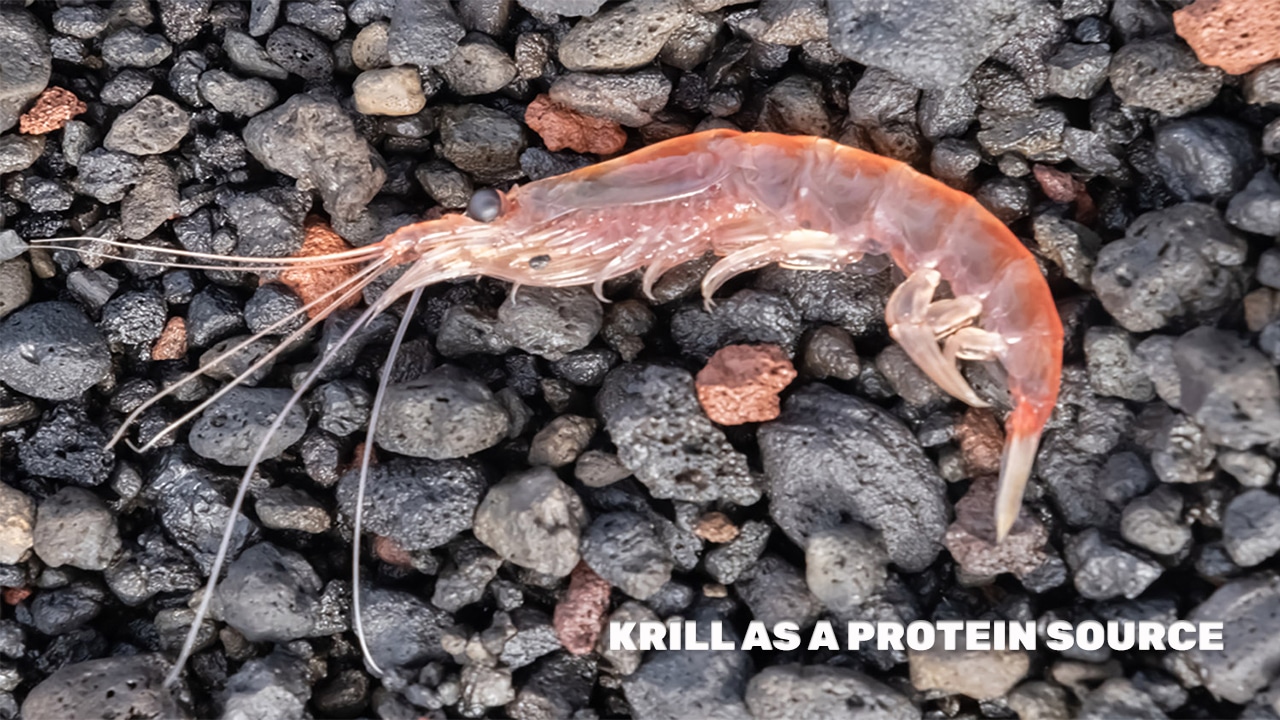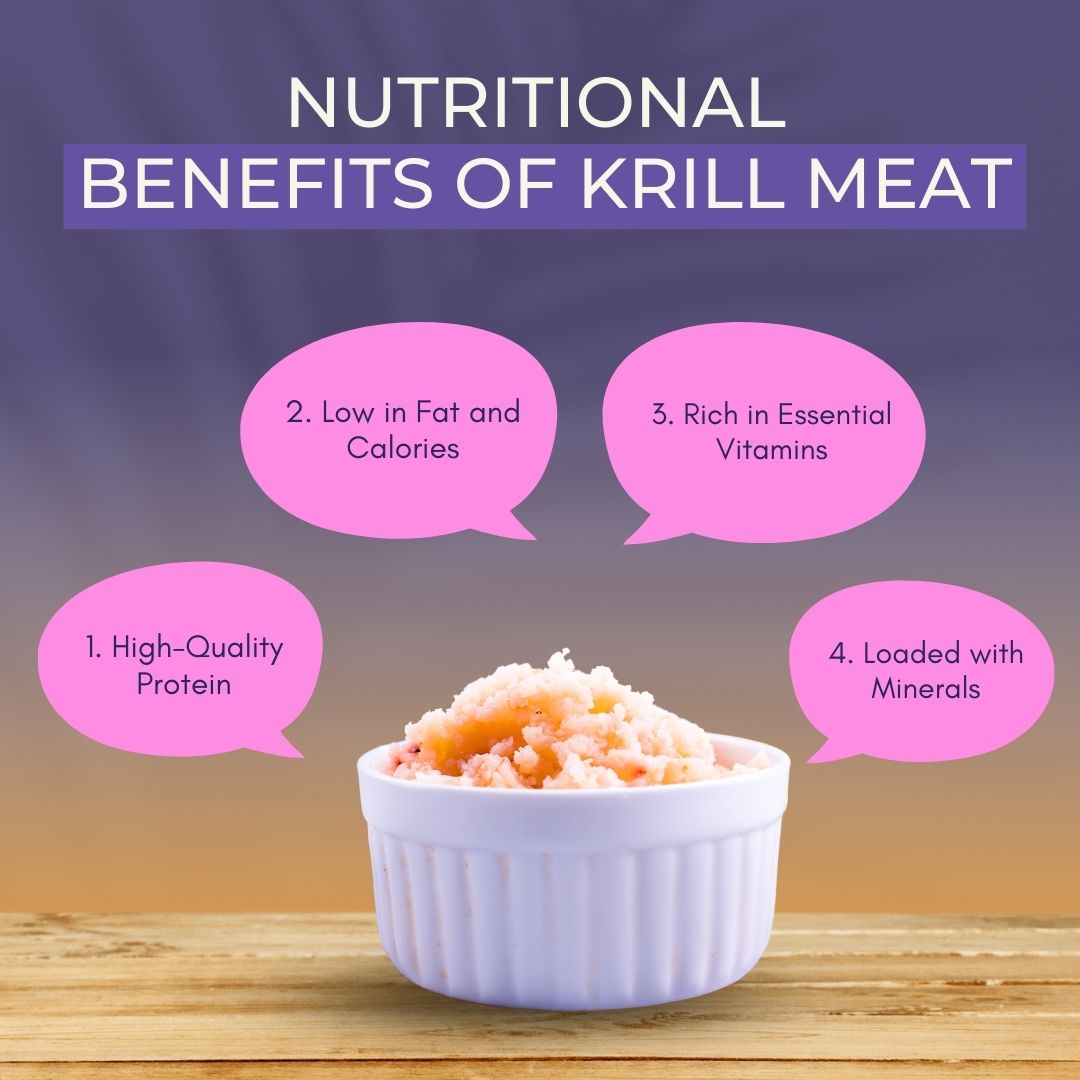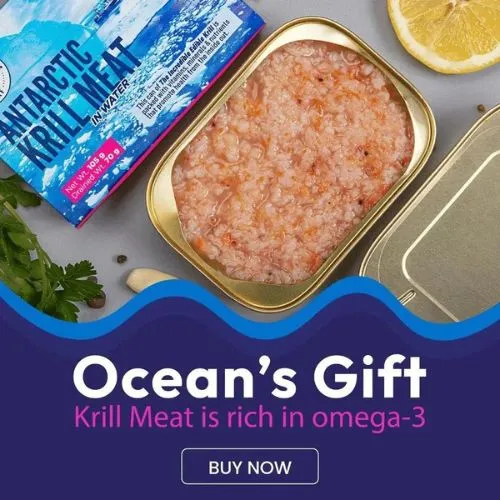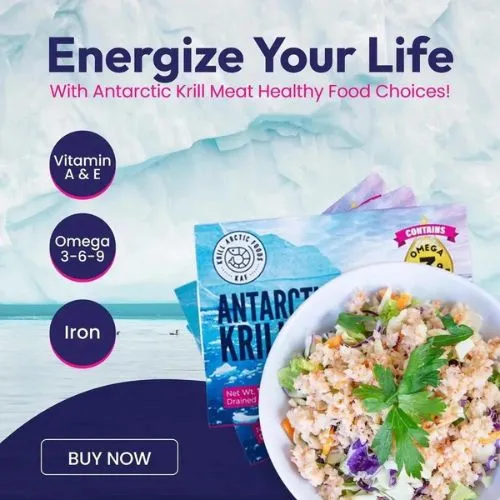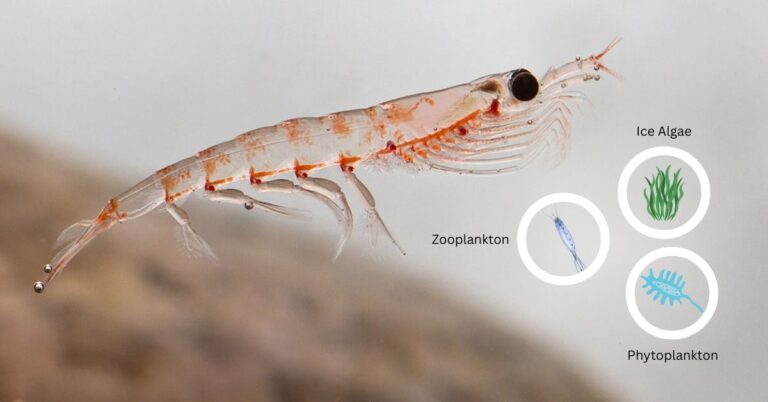Protein fuels the body, but not all protein is created equal. Many of today’s common sources of meat, fish and plant-based proteins come with challenges. Beef requires large amounts of land, water, and feed to produce. Plant-based proteins lack essential amino acids and often require artificial fortification. Even seafood like salmon and tuna, while rich in omega-3s, contains fats that are harder for the body to absorb.
Why krill is the protein of tomorrow becomes clear when you consider its advantages. Krill, a tiny crustacean from the Antarctic, changes the game. It provides a highly digestible, complete protein packed with essential nutrients while being one of the cleanest and most sustainable protein sources available. Since krill sits at the bottom of the food chain, it doesn’t accumulate mercury or heavy metals, making it a safer and purer seafood choice.
So read on, because krill isn’t just another protein option, it’s the future of sustainable, nutrient-rich eating. In this article, we’ll explore what makes krill superior, how it compares to other protein sources, and why it’s revolutionizing the way we think about nutrition.
The Global Need for Better Protein Sources
The world is consuming more protein than ever. With a rising population, increasing health awareness, and growing demand for high-protein diets, the need for sustainable, nutrient-rich protein sources has never been greater.
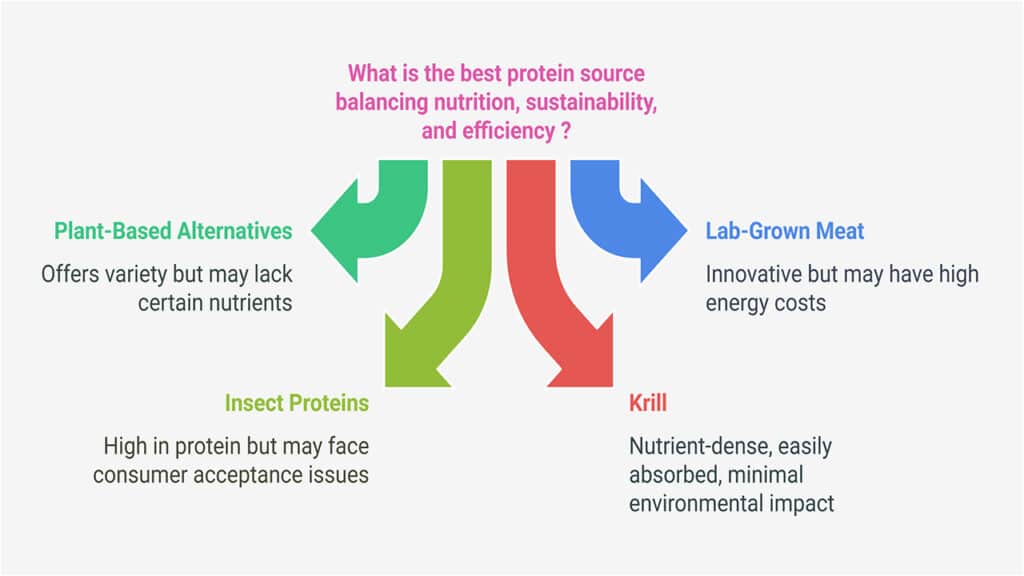
But there’s a problem current protein production can’t keep up. Traditional farming and fishing aren’t scalable enough to meet future needs. Livestock farming also has challenges, while overfishing is pushing marine populations to the brink. Meanwhile, climate change is making food production more unpredictable. So we need alternative protein solutions to support both human health and environmental balance.
Each major protein source comes with serious challenges:
Animal-Based Proteins
- Farming limitations – Raising livestock takes too much land, water, and feed, making it unsustainable for long-term growth.
- Environmental damage – Meat production contributes to deforestation, greenhouse gas emissions, and biodiversity loss.
- Overfishing concerns – Wild fish populations can’t recover fast enough to meet demand, threatening ocean ecosystems.
Plant-Based Proteins
- Lower protein quality – Many plant proteins lack essential amino acids and require fortification to be nutritionally complete.
- Digestibility issues – Some plant proteins contain antinutrients, making them harder for the body to absorb.
- Farming challenges – Large-scale plant protein production relies on monocropping, which depletes soil nutrients and increases pesticide use.
Lab-Grown Meat
- Not ready for mass consumption – It’s still too expensive to produce at scale.
- Energy-intensive production – Creating lab-grown meat requires significant energy, raising concerns about long-term sustainability.
- Uncertain health impacts – Since it’s a new technology, its long-term effects are still unknown.
With rising demand, environmental challenges, and limitations in traditional protein production, the world needs a sustainable, efficient, and nutritionally superior alternative.
What Makes Krill a Game-Changing Protein?
The search for a better protein source has led to plant-based alternatives, lab-grown meat, and insect proteins but none have truly solved the problem of balancing nutrition, sustainability, and efficiency. That’s where krill stands apart. This tiny Antarctic crustacean packs a nutritional punch, is easier for the body to absorb, and is harvested with minimal environmental impact.
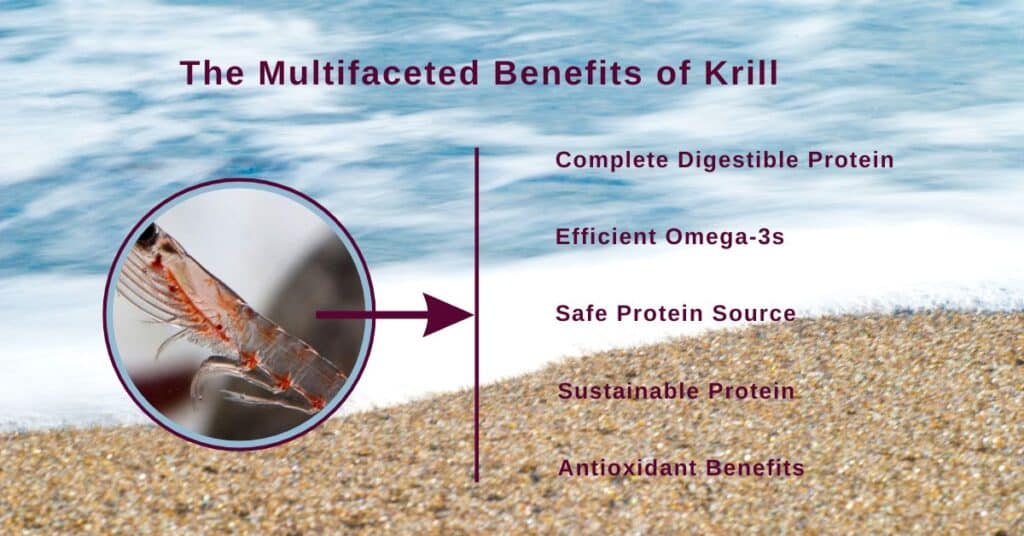
A Complete and Highly Digestible Protein
The quality of protein isn’t just about how much you eat it’s about how well your body can use it. Krill delivers all essential amino acids, making it a complete protein, just like meat, eggs, and fish. But what sets it apart is its digestibility.
- Krill protein is easier for the body to break down and absorb than beef, poultry, or fish.
- High bioavailability means more protein is used for muscle repair, energy, and cell function, instead of being wasted.
- Unlike some plant proteins, krill protein doesn’t require artificial fortification to match the body’s needs.
Simply put, krill gives you more usable protein per bite.
Omega-3s That Work Smarter, Not Harder
Many people turn to fish for omega-3s, but there’s a problem fish store omega-3s as triglycerides, which the body takes longer to absorb. Krill, however, binds omega-3s to phospholipids, which the body absorbs faster and uses more efficiently.
What does this mean? More heart, brain, and joint benefits from a smaller amount of omega-3s.
Plus, krill contains astaxanthin, a powerful antioxidant that protects omega-3s from oxidation, keeping them fresher without the need for artificial preservatives.
A Cleaner, Safer Protein Source
Unlike large fish like tuna and salmon, krill is naturally low in mercury and heavy metals. Since krill feed on microscopic algae, they don’t accumulate the toxins that build up in bigger fish. This makes krill one of the cleanest, purest seafood choices available.
- No mercury concerns, making it safe for all ages.
- No antibiotics or artificial farming methods, unlike livestock or farmed fish.
- Naturally protected from oxidation by astaxanthin, reducing the need for chemical additives.
A Sustainable Protein with a Minimal Environmental Footprint
Sustainability is one of the biggest challenges in protein production. Meat and fish require massive amounts of resources, while plant-based proteins often rely on industrial farming. Krill, however, is one of the most abundant and responsibly harvested protein sources on Earth.
- Krill is harvested under strict CCAMLR regulations, ensuring minimal environmental impact.
- Less than 1% of the total krill biomass is harvested annually, keeping populations stable.
- Krill requires no land, no fresh water, and no feed, making it far more sustainable than livestock or farmed fish.
Packed with Antioxidants for Extra Health Benefits
Krill doesn’t just provide protein and omega-3s it also delivers a unique boost of natural antioxidants, thanks to astaxanthin. This powerful compound:
- Reduces inflammation, helping with muscle recovery and joint health.
- Supports skin health, slowing down signs of aging and protecting against UV damage.
- Boosts immunity, helping the body fight oxidative stress and free radical damage.
Why Krill Is a Sustainable Protein Choice
The search for better protein sources isn’t just about nutrition it’s about finding options that don’t harm the planet. While meat, fish, and plant-based proteins strain natural resources, krill stands out as a low-impact, environmentally responsible choice.
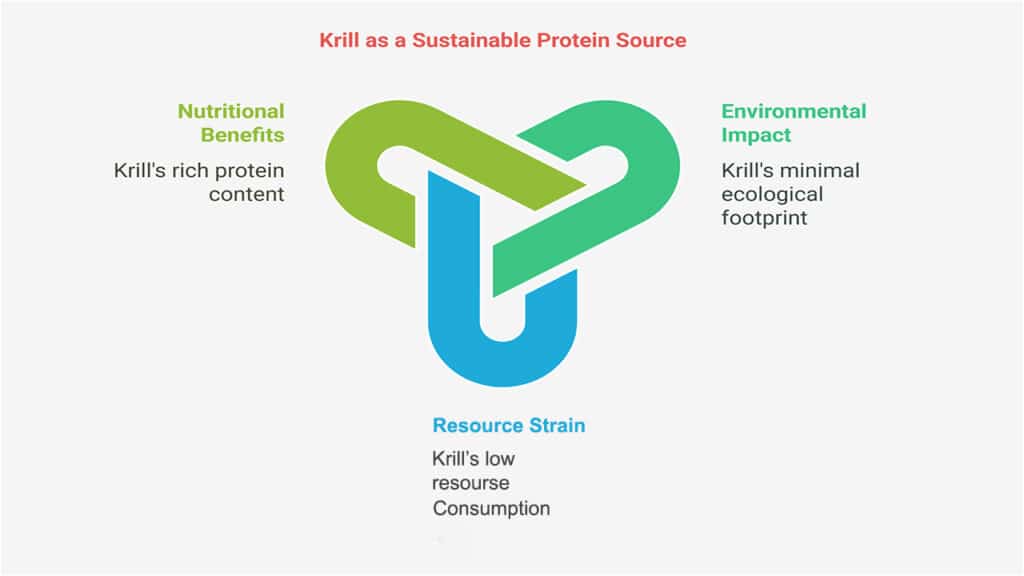
Responsibly Harvested Under Strict Regulations
Overfishing is a major problem, with fish populations declining due to high demand. Krill, however, is harvested under strict global regulations, ensuring that its populations remain stable.
- The Commission for the Conservation of Antarctic Marine Living Resources (CCAMLR) sets strict limits on krill harvesting.
- Less than 1% of the total krill biomass is harvested annually, preventing overfishing.
- Real-time monitoring ensures harvesting does not disrupt marine ecosystems.
These safeguards make krill one of the most responsibly sourced proteins on the planet.
Abundant and Naturally Replenishing
One of the biggest challenges with traditional seafood is the slow population recovery. Many fish species take years to reproduce, and overfishing can wipe out entire populations. Krill, however, is one of the most abundant species on Earth, with an estimated biomass of 500 million metric tons.
- Krill reproduce in massive numbers, making them a naturally renewable resource.
- Because they are low on the food chain, harvesting krill doesn’t disrupt the balance of marine life when managed properly.
- Unlike land-based proteins, krill requires no land, fresh water, or feed, making it one of the most efficient protein sources available.
Low Environmental Impact Compared to Other Proteins
Meat, fish, and plant-based proteins all have environmental costs. Raising livestock requires deforestation, massive water use, and significant carbon emissions. Industrial fishing damages marine habitats, and large-scale plant farming depletes soil nutrients and relies on heavy pesticide use.
Krill, in contrast, has a minimal environmental footprint:
- No deforestation, no freshwater use, no land occupation.
- No need for antibiotics, hormones, or artificial feed.
- No large-scale habitat destruction or bycatch of other marine species.
Simply put, krill is one of the cleanest and most eco-friendly proteins available.
Reducing Pressure on Overfished Species
As demand for seafood increases, many fish species are being pushed to the brink. Tuna, cod, and salmon populations have declined dramatically due to overfishing. Choosing krill helps take pressure off these species, allowing them to recover while still meeting global protein needs.
- By diversifying protein sources, krill helps create a more balanced, sustainable seafood industry.
- It provides an alternative to overfished species without sacrificing nutrition.
Supporting a Sustainable Future
Sustainability isn’t just about what we eat today it’s about ensuring future generations have access to nutritious, environmentally responsible food sources. Krill’s unique combination of abundance, efficient harvesting, and minimal impact makes it a long-term solution for feeding a growing population.
How to Incorporate Krill Protein into Your Diet
Krill isn’t just nutritionally superior and sustainable it’s also easy to add to your diet. Whether you prefer whole foods, supplements, or protein powders, krill offers a simple way to upgrade your nutrition.
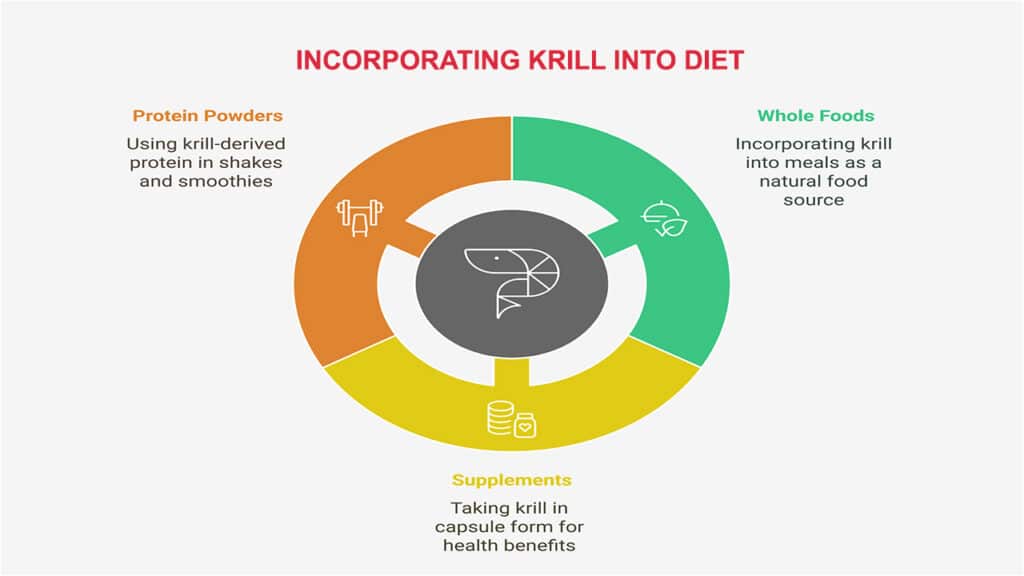
Krill Meat: A High-Protein, Nutrient-Dense Food
Krill meat has a mild, slightly sweet flavor, similar to shrimp but with a softer texture. It’s a great addition to many dishes and provides high-quality protein, omega-3s, and antioxidants in one bite.
- Salads & Wraps – Add krill to fresh greens or whole-grain wraps for a light, protein-rich meal.
- Soups & Stews – Stir krill into miso soup, chowders, or seafood stews for extra flavor and nutrition.
- Stir-Fries & Pasta – Sauté krill with vegetables or mix it into pasta for a quick, nutrient-packed dish.
- Rice Bowls & Sushi – Use krill in sushi rolls or pair it with brown rice and avocado for a healthy meal.
- Krill Cakes – Blend krill with breadcrumbs and seasoning to make krill patties, a delicious twist on crab cakes.
Krill-Based Protein Supplements
For those who want the benefits of krill without cooking, krill-based protein supplements offer a convenient and effective solution.
- Krill Protein Powder – A great alternative to whey or plant-based protein powders, perfect for smoothies, protein bars, and shakes.
- Krill Oil Capsules – Packed with omega-3s, protein, and astaxanthin, these capsules support heart, brain, and joint health without the fishy aftertaste of traditional fish oil.
Conclusion: The Protein of the Future
The search for a better, cleaner, and more sustainable protein leads to one answer, krill. It delivers high-quality, highly digestible protein, superior omega-3s, and powerful antioxidants while having one of the lowest environmental impacts of any protein source.
Unlike traditional options, krill doesn’t require deforestation, large-scale farming, or heavy processing. It’s abundant, responsibly harvested, and naturally rich in essential nutrients. Whether you choose krill meat, protein supplements, or krill oil capsules, incorporating this powerhouse into your diet is an easy step toward better health and a more sustainable future.
So read on, because krill isn’t just another protein, it’s the smart choice for those who want better nutrition without compromising the planet. The future of protein is already here. Are you ready to make the switch?

